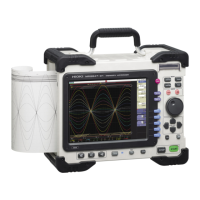13.3 Setting FFT Analysis Conditions
214
The window function defines the segment of the input signal to be analyzed.
Use the window function to minimize leakage errors. There are three general types of window functions:
The non-rectangular window functions generally produce lower-level analysis results. By applying attenu-
ation correction, the attenuation introduced by the non-rectangular window functions can be corrected to
bring analysis results back to similar levels.
13.3.5 Setting the Window Function
• Rectangular Window
• Hann window
• Hamming window
• Blackman window
• Blackman-Harris window
• Flat top window
• Exponential window
1
Select the window function.
Move the cursor to the [Window] item.
See: "Window Function"( p.A22)
2
If [Exponential] is the selected type
Set the attenuation coefficient (percentage).
Move the cursor to the [Attenuation rate] item.
Set the attenuation coefficient as a percentage.
3
Set attenuation correction.
Move the cursor to the [Compensation] item.
Rectangular (default setting), Hanning, Hamming, Blackman, Black-
man Harris, Flat-top, Exponential
None Attenuated window function values are not corrected.
(default setting)
Power
The window function multiplies the power levels of the time-do-
main waveform so that output levels are comparable to those
of a rectangular window.
Average
The window function multiplies the average value of the time-
domain waveform so that output levels are comparable to
those of a rectangular window.
Procedure
To open the screen: Press the STATUS key → [Status] sheet
See: To set from the Waveform screen (
p.225)
Correction value
For the rectangular window function:
The correction value is always 1 (0 dB).
When the attenuation rate is 10%
10%
100%
Noise is suppressed in the attenuated wave-
form.
2
1
3

